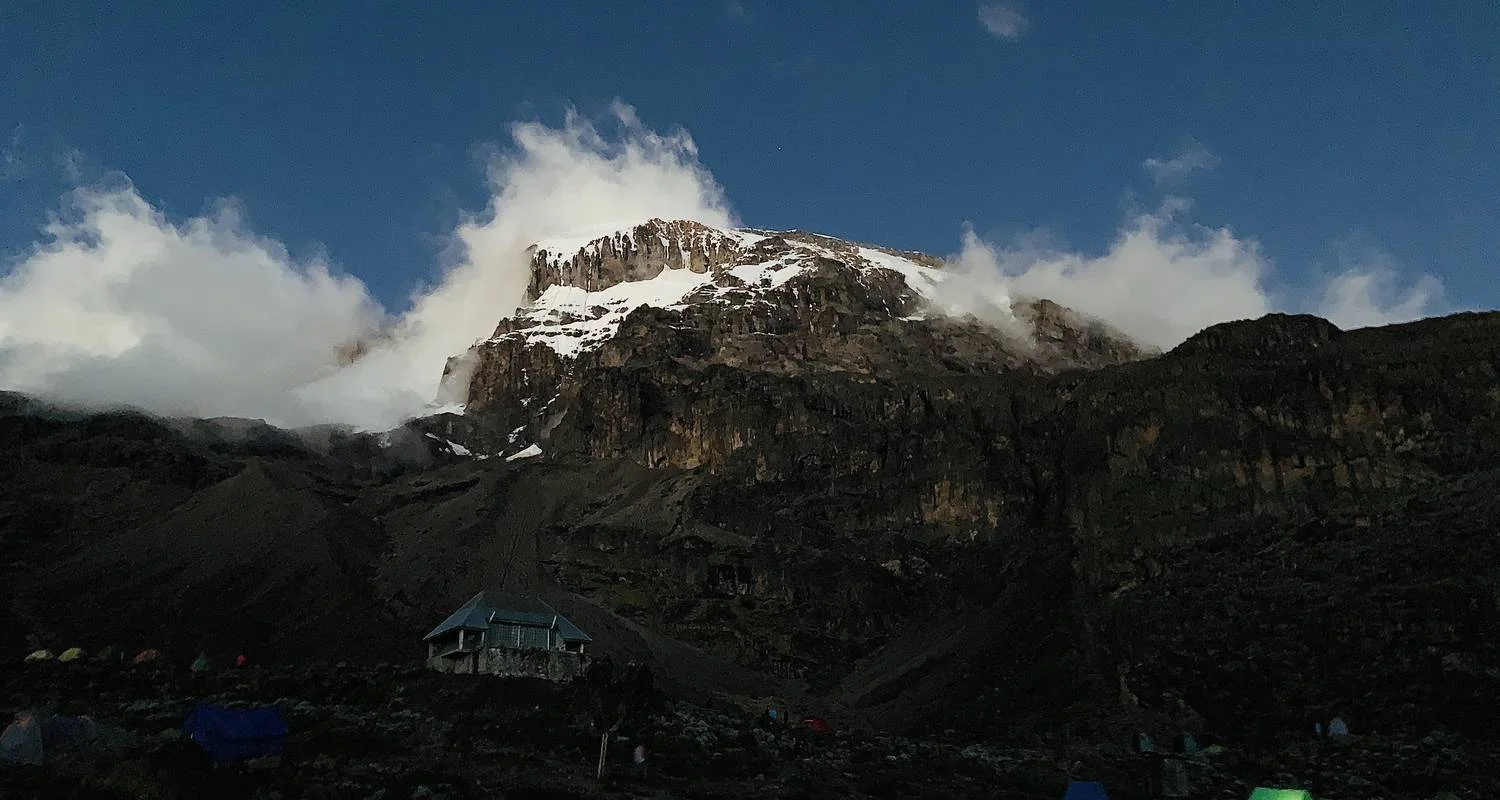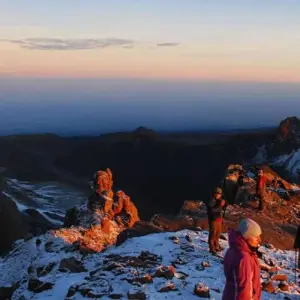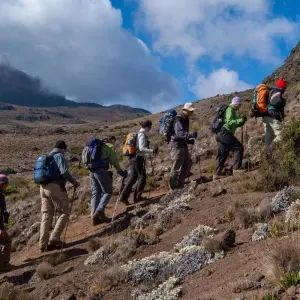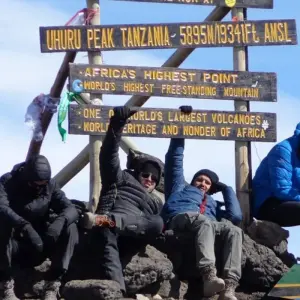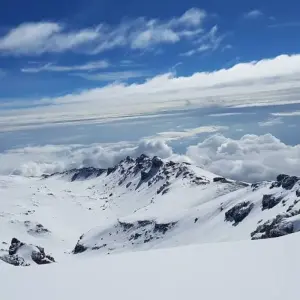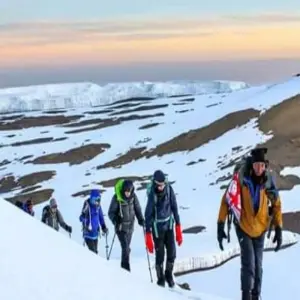Arrive anytime at Kilimanjaro International Airport (JRO). We will arrange a private transfer from Kilimanjaro International Airport (JRO) to your Hotel and Hotel is included, We will gather in the hotel for a pre-climb briefing and an equipment check. We will also confirm you have the appropriate mandatory medical coverage and travel insurance. The Kilimanjaro trekking begins and end at moshi.
Itinerario
The Lemosho route is considered Kilimanjaro’s most scenic trail. The route includes some steep passages. During the ascent, you often have excellent views of Mt. Meru, west of Kilimanjaro, and Kenya.
You use different ways for ascent and descent. On the campsites along the route, you sleep in tents. All campsites are in direct radio contact with the management of the national park. The number of visitors on this route is comparatively low.
The first two days are spent trekking across the rainforest to Shira Ridge from there. In an enjoyable, reasonably flat walk, the Lemosho path spans the entire Shira Plateau from west to east. Crowds are poor until the road near Lava Tower joins the Machame route. Then the road travels on a trail known as the Southern Circuit under Kilimanjaro’s Southern Ice Field before climbing from Barafu. The descent is carried out via the Mweka road.
Book this 8 Days Lemosho Route, Relax and let our team do the rest for you from the arrangements of the whole tour to the end, If you need any assistance from us, such as hotel reservations or transportation, please let us know and we will be very happy to assist you.
Programa del tour
Llegada al aeropuerto internacional de Kilimanjaro
De la Puerta de Lemosho (2385 m) al Campamento Big Tree (2780 m)
After breakfast and briefing, drive to Londorossi Park Gate, about a 3-hour trip. From here, a forest track requiring a 4WD vehicle leads to Lemosho Glades (2390 m) where you will start your trek through the rainforest.
Walk along forest trails to Mti Mkubwa campsite (2750 m).
Trekking Time: 3 hours | Distance: 7 km | Altitude Gain: 360 m
Campamento Big Tree (2780 m) a Campamento Shira 1 (3500 m)
After breakfast, we continue as the trail’s steepness gradually increases and enters the giant heather moorland zone. After several streams are crossed we continue over the Shira Ridge then gently downwards to Shira 1 camp (3505 m) located by a stream on the Shira Plateau.
Trekking Time: 6-7 hours | Distance: 10 km | Altitude Gain: 755 m
Campamento Shira 1 (3500 m) a Campamento Shira 2 (3900 m)
A gentle hike across the plateau leads to Shira 2 camp (3810 m) on moorland meadows by a stream. A variety of short hikes are available on the Plateau, making this a good acclimatization day.
TrekkingTime: 3-4 hours
| Distance: 8 km |
Altitude Gain: 305 m
Campamento Shira 2 (3900 m) a Campamento Barranco (3960 m)
From the Shira Plateau, we continue to the east, passing the junction near the peak of Kibo. As we continue, our direction changes to the South East towards the Lava Tower, called the “Shark’s Tooth.” Shortly after the tower, we come to the second junction, which brings us up to the Arrow Glacier (4876 m). We now continue down to the Barranco Hut (3860 m). Although you end the day at the same elevation as when you began, this is another important day for acclimatization.
TrekkingTime: 6-7 hours |
Distance: 10 km |
Altitude Gain: 50 m
Campamento de Barranco (3960 m) a Campamento de Karanga (3963 m)
We start the day by descending into the start of the Great Barranco, a huge ravine. We then exit steeply, up what has been termed the Breakfast Wall. It is a climb over rocks, not technical but long and tiring.
Passing underneath the Heim and Kersten glaciers, we head towards the Karanga Valley (4000 m) overnight. Trekking Time: 3-4 hours
| Distance: 6 km
| Altitude Gain: 140 m
Campamento de Karanga (3963) a Campamento de Barafu (4640 m)
After a good night’s rest and breakfast, we set off on our walk to Barafu camp at 4640m. The climb will take us across desolate scree slopes with no vegetation around us at all. It’s a tough steep walk made more difficult by the altitude. On arriving at camp we eat and spend the afternoon resting as we prepare for a long night and day ahead. It is important to keep hydrated and warm. We have an early dinner and then try to get some sleep as we will be getting up between 11 pm and 12 pm to start the climb to the summit.
Campamento de Barafu (4.680 metros) a Pico Uhuru (5.895 metros) y luego Campamento de Mweka (3.100 metros)
You will be awoken around 23:30 with hot tea and biscuits. Hopefully, you have managed to get a few hours sleep; don’t worry if you haven’t as most people struggle to sleep before summit night. Do however make sure that all your kit, including warm clothes, headlamp, insulated water reserves, and snacks are ready for a sharp departure at 24:00. The trek up Kibo is steep and slow. The trick is to keep your momentum moving forward, one step at a time. It takes about 6-8 hours to reach the top of the crater rim where you will see the sign for Stella Point (5,739 meters). You still have another 156 meters of altitude to walk around the crater rim to Uhuru Peak (5,895 meters). After reaching the summit of Kilimanjaro, a 4.5km / 3-mile ascent, you still have an 11km / 7-mile descent to Mweka Camp (3,100 meters)! Mweka is situated in the upper part of the rainforest zone. The richness of oxygen and moisture in the air will be a very welcome surprise.
Campamento de Mweka (3.100 metros) a Puerta de Mweka (1.640 metros)
In the morning after breakfast, you will be trekking down to Mweka gate. The trek is a pleasant one through the lower rain-forested slopes and down to Mweka Gate (1,640 meters). Although you cover 9km / 5.5 miles, the trek only takes 3-4 hours. Assuming you successfully reach Stella Point or Uhuru Peak you will be presented with official certificates – a green certificate for the former and a gold certificate for the latter. It is customary to tip your trekking crew before being transported back to your hotel in Arusha.
The end of 8 Days Lemosho Route
Salida
This day left for your next destination. If you have safari, then might be used to beginning your safari or fly to Zanzibar or fly back home. Our vehicle will be ready to take you to the airport at your time.
Detalles del tour
Alojamiento
El viaje incluye alojamiento para dos noches, la noche antes de la ascensión y la noche después de la ascensión, en caso de que dispongas de algún día más que estará de tu parte
Alojamiento antes de la ascensión (desayuno incluido; compartiendo habitación doble)
Alojamiento después de la ascensión (desayuno incluido; compartiendo habitación doble)
Durante la ascensión compartirás tienda: 2 personas en cada tienda.
Si necesitas una tienda individual, ponte en contacto con nosotros)
Guía
Nuestros guías del Kilimanjaro tienen mucha experiencia, y la mayoría ha escalado más de 150 veces. Son profesionales que conocen confidencialmente la montaña Todos los guías tienen los certificados "Wilderness First Responder" y "Wilderness First Aid".
Comidas
El menú del Kilimanjaro está diseñado para garantizar que tu ingesta de alimentos se corresponda con tu nivel de esfuerzo. Te proporcionará un buen equilibrio de proteínas, hidratos de carbono, fruta y verdura. Cuando estás en altitud puedes empezar a sentir náuseas y se te puede quitar el apetito, por lo que las comidas preparadas a gran altitud suelen contener más hidratos de carbono y menos proteínas para ayudarte a digerir los alimentos.
Tus cocineros prepararán las comidas en el Kilimanjaro y los porteadores las transportarán.
El menú de un día típico incluirá lo siguiente:
Desayuno
Gachas
Tostadas
Tortitas
Huevos
Salchichas ahumadas
Fruta fresca (piña, melón o naranjas)
Té / café / chocolate caliente
Almuerzo
Bocadillos
Fruta fresca
Huevos duros
Galletas
Zumo de fruta
Cena
Sopa
Pasta / Arroz / Patatas
Pollo / Ternera
Verduras
Ensalada
Fruta fresca
Servicios adicionales
Todos los traslados a la montaña y de vuelta a tu hotel de Moshi
Guías de montaña profesionales y experimentados
Salarios de guías, porteadores, cocineros y tasas del parque
Colchón para dormir
Bombona de oxígeno de emergencia
Todas las comidas en la montaña
Tiendas comedor de calidad con mesa y sillas
Grandes raciones de comida fresca, sana y nutritiva
Agua potable limpia y purificada
Tasas de conservación (parte de las tasas del parque)
Tasas de acampada o cabaña (parte de las tasas del parque)
Tasas de rescate (parte de las tasas del parque)
IVA (18% cobrado por el Gobierno)
Certificado de cumbre del Kilimanjaro
Transporte
Traslado del Aeropuerto del Kilimanjaro al hotel en Moshi y del Hotel de vuelta al Aeropuerto por fin
Recogida desde el Hotel hasta la puerta del Kilimanjaro y recogida desde la puerta del Kilimanjaro de vuelta a Moshi por fin está incluido
Bueno saber
Divisa
Tanzanian Shilling
Tanzania
Enchufes y adaptadores


